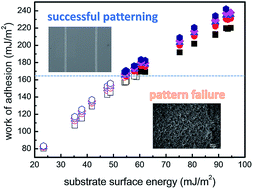Critical work of adhesion for economical patterning of silver nanowire-based transparent electrodes
Abstract
The lithographic process for flexible transparent electrodes is essential for constructing wearable optoelectronic devices with a well-defined active area. Although photolithography is a well-established patterning process, and can generate small features, it involves toxic materials and high processing cost. Herein, we introduce a novel lithographic process for both silver nanowire (AgNW)-embedded and AgNW-exposed flexible transparent electrodes. We selectively control the adhesion between AgNWs and the substrate via a local surface treatment with ultraviolet/ozone (UV/ozone), oxygen plasma, and atmosphere plasma. Since strong adhesion leads to retention of AgNWs on the substrate during embedding of AgNWs in a UV-curable polymer, selective control of adhesion induces selective embedding of AgNWs, generating AgNW-embedded and AgNW-exposed transparent electrodes with desirable patterns. Additionally, this process is versatile enough to be applicable to various substrates including poly(methyl methacrylate) (PMMA)-coated surfaces, poly(ethylene terephthalate) (PET) films, and acrylic substrates, and various AgNWs with different surface energies. The critical work of adhesion to successfully pattern AgNW-based transparent electrodes is experimentally obtained. Conclusively, we demonstrate that patterning of AgNW-based electrodes by controlling the work of adhesion is economical and eco-friendly, and can be successfully applied for designing various optoelectronic devices such as organic photovoltaic cells and liquid crystal cells.



 Please wait while we load your content...
Please wait while we load your content...